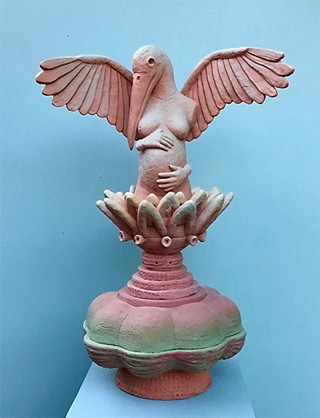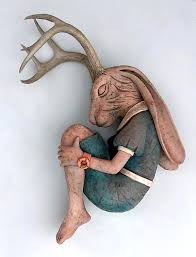This exhibition of ceramic sculptures recasts fairy tales with animals who are more human than the people in the originals
REVIEWED BY ROBERT FAIRES

Resilience by Marianne Levy
You'd recognize that Evil Queen anywhere. Golden crown with tall, spiky points; skintight dark hood with a widow's peak; long black cape; high curled collar; bloodred jewel at the throat – who rocks that eerie ensemble but Her Majesty "Who's the Fairest in the Land" in Disney's Snow White, right? She's even holding a mirror.
One thing, though: Instead of the icy, imperious human face she has in the animated film, this Evil Queen has a cougar's mug poking out of that hood. With the head two sizes too large for its body and the innuendo of the metaphor – a middle-aged predator on the prowl for young Princes Charming – the character turns from sinister to silly. And yet the more you look at it, the more this puss' puss appears, well, kind of sad. The downcast eyes and open mouth suggest a sorrow brought on by the reflection in the glass, as if the cougar sees there that its days as a fearsome hunter have passed.
In "Grimm Re-Articulated," the show of ceramic works by Marianne Levy at the Dougherty Arts Center's Butridge Gallery (now, sadly, closed to the public because of the coronavirus), this dynamic plays out again and again: a piece references a figure familiar from a fairy tale of old (or its more recent Mouse House incarnation) with an animal in place of the person; the beast in human garb creates a comic effect, but its expression and gestures are those of a human feeling something darker, weightier – longing, disappointment, regret.
Of course, the tradition of giving animals human traits in service of art and literature is a long one, going back to Aesop, if not before, and its creatures have portrayed the full range of emotions. Still, Levy's beasts are striking in their poignance, the sense of loss they convey. In Rapunzel in the Clouds, a horse's head is surrounded by doughy clumps of clouds from which hang long lilac strings that reach the floor and pool there – the picture of a steady shower. More strings hang thickly off the horse's neck – the mane as Rapunzel's hair – and seem to weigh down her head, and perhaps her spirit. With her head down and eyes in shadow, she projects woe. Nearby is Resilience, which shows a stork's head on the nude body of a pregnant woman, with disembodied human hands caressing her swollen belly. The stork's wings are extended, like those of a protecting angel, but its head is tilted downward, the long beak resting on one breast, the closed mouth a long solemn line. Is it a sign of melancholy? Worry? Shame? Whatever it is, the feeling is deep.
Most of the pathos in the other sculptures is, as in Cougar Queen, masked in comic visuals. Levy makes Hansel and Gretel wolves, and just the sight of a wolf in lederhosen tickles the ribs. But the face of this lupine Hansel bears a look of pained sympathy, and his human hand rests consolingly on his sister's shoulder as she, her eyes lowered and mouth open, appears to be confessing something distressing. Whatever troubles her – that they're lost, that they killed the witch – it reveals vulnerability in these animals we associate with preying on the vulnerable. In another piece, an ostrich wearing Cinderella's ball gown from Disney's animated film sits in a large chair. The incongruity of this huge, ungainly bird in a setting of elegance and refinement is good for a laugh – as Disney himself showed when ostriches danced ballet in the "Dance of the Hours" segment of 1940's Fantasia – and Levy builds on the gag with the ostrich's feet sticking out from under the gown; it's tough to picture glass slippers fitting over those two-toed gunboats with the giant claws. The sight gag's so complete that you might miss seeing what this Cinderella cradles in one arm: another ostrich's skull. That alters the mood of the image, as do the serpent devouring its tail on top of the chair and the title, Memento Mori. What was a joke becomes a tale of mortality – that which must inevitably be faced even by those said to live "happily ever after."
And so it goes in "Grimm Re-Articulated": An octopus is Sleeping Beauty's Maleficent, a goose is her fairy godmother, and a sloth is Beauty herself; a possum wears Snow White's dress, while a bat is in Belle's gown from Beauty and the Beast; a lamb, an owl, and a rajasaurus take turns as Little Red Riding Hood. And whatever the beast, however comical the juxtaposition of fairy tale and fauna, Levy is able to draw from it some pang, some ache. Such are the artist's empathy and artistic skill that she's able to balance humor and pathos with Chaplinesque deftness. She makes us see creatures face isolation, loneliness, failure, middle age, birth, death, and in their fur and feathers recognize ourselves. Her animals turn out to be more human than the characters in those fairy tales are – and maybe more than we are as well.
"Marianne Levy: Grimm Re-Articulated"
Julia C. Butridge Gallery at the Dougherty Arts Center, 1110 Barton Springs Rd.www.austintexas.gov/jcbgallery
Through July 24 (but closed to the public)
A version of this article appeared in print on July 10, 2020 with the headline: “Marianne Levy: Grimm Re-Articulated” at the Dougherty Arts Center

Butridge Gallery: Grimm Re-Articulated
https://www.austinchronicle.com/events/arts/visual-arts/butridge-gallery-grimm-re-articulated-272079...








